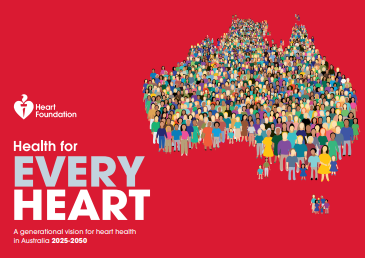
Heart disease is a complex issue that impacts the lives of millions of people in Australia. It’s not simply a medical problem, but one that is also deeply connected to social, economic, and environmental factors. These factors interact in a complex web, making it harder to reduce the burden of heart disease on a population level.
Understanding these intricate relationships is crucial for developing solutions that can reduce the impact of heart disease. To support its long-term vision-setting process, the National Heart Foundation of Australia tasked the Sax Institute with creating a systems map to better understand the complex interplay of factors contributing to heart disease in Australia.

This map – also known as a causal loop diagram – is a visual representation of the range of factors and their complex relationships influencing both the rate of heart disease and its impact on people in Australia. Causal loop diagrams can help diagnose system behaviours, identify where it is most effective to intervene and design the right strategies to have greatest system impacts.
To build the map, we took a systems thinking approach and tapped into the knowledge and experience of a broad range of stakeholders – including cardiologists, GPs, allied health practitioners, researchers, and policy makers – through interactive workshops and webinars to develop a shared understanding of the multiple drivers of the complexity of heart disease. This process allowed us to identify eight key interconnecting domains driving current trends in cardiovascular disease outcomes. Among others, these domains include patient access to services; effectiveness of prevention, treatment, and management; primary care engagement; prevalence of risk; and cardiovascular disease burden.
Overall, our causal loop diagrams show the need for a more multifaceted approach to cardiovascular disease (CVD) prevention and management that encompasses both operational effectiveness and risk perception factors to improve patient engagement, service delivery, and health outcomes.
“The face of cardiovascular disease is changing,” says Dr Danielle Currie, Deputy Director of Simulation Modelling at the Sax Institute. “Previous approaches, including technological advances, addressed the low hanging fruit of survival rates but they have now largely reached their potential. The new face of CVD is more complex and harder to reach and needs new approaches to make further progress.”
Insights from our causal loop diagram are helping the Heart Foundation to understand the likely impact of the priorities it has set; identify potential strategies that may have been otherwise overlooked; and explore the impacts of scaling research. This critical work is helping to lay the groundwork for effective, strategic action over the next 25 years to reduce heart disease prevalence and improve quality of life for those living with the condition.
See Health for Every Heart for details on the Heart Foundation’s 25-year vision.





